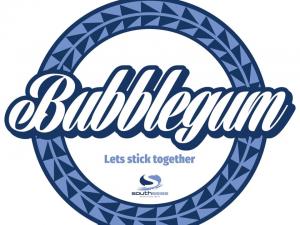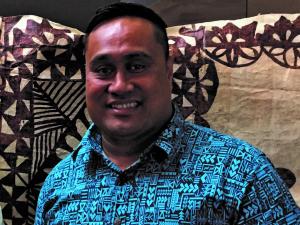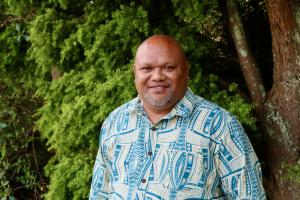Respiratory physician Lutz Beckert considers chronic obstructive pulmonary disease management, including the prevention of COPD, the importance of smoking cessation and pulmonary rehabilitation, and the lifesaving potential of addressing treatable traits. He also discusses the logic of inhaler therapy, moving from single therapy to dual and triple therapy when indicated, as well as other aspects of management
‘He’ll keep taking the hits.’ A Samoan Kiwi who just wants to help Pacific health progress
‘He’ll keep taking the hits.’ A Samoan Kiwi who just wants to help Pacific health progress

Alan Perrott meets a man who pushed for Ōtara, south Auckland, to get a ‘gold-standard’ COVID-19 community-based assessment centre last year
Silao Vaisola-Sefo, South Seas Healthcare chief executive
Heritage: Gagaifo o le Vao village, Samoa
Arrived in New Zealand: Aged eight years old
Mentor of note: Rugby player Anton Oliver
Favourite business book: The Fifth Discipline: The Art and Practice of the Learning Organization
University qualification: Commerce, majoring in Management
First job in health: Community development officer at Counties Manukau DHB
The system has to change, it's designed for competition, not collaboration, and it incentivises the wrong things
A fair chunk of Ōtara’s homegrown COVID-19 response can be credited to the words of former All Black captain and nude model, Anton Oliver.
For those short on rugby history, Oliver was known as a renaissance Southern Man, patron of the arts, environmentalist, and owner of the bare backside in Simon Richardson’s painting, Back Field.
“And this was the guy who was trying to mentor me,” says rugby protégé-turned-chief executive Silao Vaisola-Sefo, of South Seas Healthcare.
“He’d ask me to meet him for coffee, and he’d bring this bloody diary full of all this stuff he’d written up. He just confused the shit out of me.”
Rugby had imposed itself on Mr Vaisola-Sefo. He didn’t really enjoy the game and almost never watched it, but his mates played and he was happy to join in.
By 2001, he was an up-and-coming front-row forward, but inwardly remained a polite, humble boy who obeyed his mother. His first award after arriving in Dunedin from Samoa as an eight-year-old was a certificate for politeness.
So, he’s at his first Highlanders training session as second-string hooker, practising lineout drills.
“[Anton] had four or five throws, and all I’m doing is feeding him the ball, and he asks, ‘are you going to have a throw?’
“And, I mean, I don’t really know the guy, so I say, ‘it’s okay, you go.’ I was being polite.”
With the session over, the All Black pulled him aside. “He says to me, ‘Bro, you’ve got to take your opportunities. You snooze, you lose.’ He was saying, it’s not good enough to just be here, you have to get yourself noticed, and that has stuck with me my whole life.”
The perfect illustration of this philosophy is the “gold-plated” community-based assessment centre South Seas Healthcare established in the car park of the Ōtara Shopping Centre last year. With its marquees, brash signage and music, it was built to be noticed.
“You know, I got a hard time about that, and the cost, but Ōtara has always missed out, and I didn’t want this community to be exactly where we still are now, where everything’s bad about south Auckland. It’s all those connotations I saw on the news, living in Dunedin. I didn’t want to use those tents you see in homicide scenes.
“So, there was a tension between South Seas and everyone else, and I didn’t expect things to go there, but it delivered results, that was the busiest station in New Zealand, and we tested the highest number of Pacific people in the country.
“It showed that, when you plant something in the community, people will be proud of it and they will use it, and that’s why we had people coming from the North Shore just to experience it.”
The outspoken chief executive still has the mantra: “You snooze, you lose” and says he’ll keep taking the hits as long as he’s helping Pacific health progress.
Silao Vaisola-Sefo was born in 1979 in Gagaifo o le Vao, a village of almost 600 people on the south-west coast of Upolo, and a 45-minute drive from the Samoan capital, Apia.
The youngest of five children, he enjoyed a life of swimming, chores and school – until the day his mother started screaming.
It was 1986, and his New Zealand-based sisters were returning from Dunedin for Christmas. After a day of decorating, it was just getting dark when his mother, Ioana Vaisola-Sefo, cried out, “saying, ‘oh my leg’; she said it was like someone was twisting it”.
And that, says Mr Vaisola-Sefo, is “where it started”.
His father, Su’a Vaisola-Sefo, was working six days a week on the family plantation – an hour’s walk away – and, together with church on Sunday, it fell to the youngest to leave school and care for Mum.
Unable to move, she stayed on a mattress, her son taking care of her toileting and shower. There was a shower beside the house, and he’d drag her outside, wash and dry her, then drag her back inside: “I was seven, man, come on.”
But he was devoted. When his mother was admitted to hospital in Apia, he would leave school and take two buses to be with her.
Giving in to the inevitable, he was allowed to stay in the ward where he became an unpaid, well-fed orderly running errands such as buying cigarettes for the patients.
The turning point came when Mrs Vaisola-Sefo returned home and was visited by their Catholic priest.
“Normally, when the priest comes, it’s like the writing’s on the wall,” says Mr Vaisola-Sefo, “but he was praying like nothing was happening.
“Then he grabbed her hand, and said, ‘It’s not your time, the church needs you; there’s more work to be done.’
“That still resonates with me.”
It was decided his mother would travel to New Zealand for further treatment, but his father would stay to work on the plantation.
Young Vaisola-Sefo had heard much of the far-off country he was soon to call home.
“It sounded like going to heaven, flash buildings and fluffy white clouds, but for some reason I didn’t think there were any trees,” he says.
His only doubts came from seeing his cousins: “When they returned they just looked pale and they smelled nice, you know? Their clothes were different and they spoke really broken Samoan.
“I said: ‘Wow, you guys are Samoan, but you don’t speak Samoan?’ They stuck out like a sore thumb.”
In March 1987, after spending a month in Auckland visiting a brother, both mother and son flew to Dunedin. (It was snowing.)
The plan was for his mother to see a specialist while they stayed with his two sisters, who worked at the Cadbury factory. A hip operation soon saw his mother’s health restored.
Master Vaisola-Sefo started at Brockville Primary without speaking any English. “There was one more Samoan boy, two Māori kids and one more kid, and that was it for the Brownies.”
He was a novelty, but was befriended as a playground ally because of his large size. He also started daily language lessons, which lasted to high school.
After being recruited by the local league club, his bulk and speed began attracting secondary school scouts. Catholic Kavanagh College was first to talk about a scholarship, but its approach was vetoed the moment Mrs Vaisola-Sefo realised the school was co-educational.
He ended up at Otago Boys’ High School. After his friends dragged him to an under-15s rugby trial, his future was sealed.
He made the first XV, and got to know another young charger, Richie McCaw, the pair becoming house prefects at the school hostel. His mother and sisters had moved to Auckland by then, but the school, keen to retain their star hooker, offered to cover his costs for the final year.
After Otago Boys shared the 1998 national rugby title, he started a commerce degree at the University of Otago while also playing provincial rugby.
Somehow his family missed the news about university and, when he called in 2003 to invite them to his graduation, they replied: “Graduation? From where?” As the first in his family to be capped, this became a very big deal.
His rugby career was ticking along nicely, but his heart wasn’t really in it and he declined an offer from South African Balie Swart to join the Sharks squad in Durban.
So why was he playing? Rugby, he says, is “the only environment where you’re with guys from all over the place, from all different backgrounds, and it was such a cool thing to work together as a team”.
“It’s about accountability; do your job, do the basics, and do them well.
“When you watch the match video, everyone sees when you miss a tackle or when you’re walking when you should be running. That’s what I liked, you can’t hide.”
Still, his life plan was to return to Samoa and open a tourism business. Mr Vaisola-Sefo was planning a venture with Samoan rugby legend Peter “Fats” Fatialofa just prior to his death.
Then another rugby legend intervened. “Michael Jones rang me, saying he’d seen me play and would I like to join the Samoan World Cup development team. All I heard was blah blah blah, I’m just thinking that Michael Jones knows who I am.”
International rugby was also his first return to 100 per cent Samoan culture since 1987.
“I walk into the team room and they’re all looking at me, and I’m: ‘Don’t look at me like that, I know what that look is! I’m one of you guys, I still speak Samoan. I only smell nice because of Lynx, there’s nothing special…”
Then he forgot to tell his parents when he made the Manu Samoa squad: “It wasn’t on purpose, it’s just my attitude towards these things: Oh, cool.”
His father took no chances with the 2007 World Cup team announcement and listened in on his neighbour’s radio, the only one in the village.
Unfortunately, Manu Samoa flopped, their tournament blighted by politics and injuries. Mr Vaisola-Sefo strained a calf muscle in the lead-up, all but ending his campaign.
He managed one appearance in the final pool game against the US. With less than 10 minutes to go, he came off the bench for a Samoa kick-off, charged into the back of an American player, and referee Wayne Barnes showed him the yellow card. He had been on the field for 30 seconds, tops.
Back in Dunedin, he accepted a contract with French club Montpellier and, with his father now in Auckland with the family, decided to spend some time with them before leaving. He arrived just as his father received a diagnosis of prostate cancer.
It had been caught early, but France was now off. It looked like Mr Vaisola-Sefo would be stuck in south Auckland, a place the media had convinced him was crime-ridden and depressed.
Needing a new plan, he enrolled at the University of Auckland, hoping to get into sports administration. Then Blues coach Pat Lam called, offering a seat on a plane for their offshore, pre-season preparation.
Off he went, and down he went. He was injured again: “My body was telling me it was over. I needed to find a job.”
In 2008, he landed a short-term position as a community development officer at Counties Manukau DHB, helping south Auckland churches implement health programmes. “The best job, you go to see the ministers and they pray for you, pray for your work,” he says. After six months, he was planning and funding manager for the programme and everything looked golden. But it wasn’t.
“I just thought I could drop rugby and pick up this other thing and it would all be good. But, for me, finishing rugby, I’d lost my identity. I was drinking and had some mental health stuff.”
Adding to the pressure, he was asked to apply for the role of general manager, Pacific health. “For me, it was like, how? I’ve never managed anything. But they said ‘just apply what you learned from your professional rugby days’ and I thought: Wow, so my rugby identity can be part of this thing? Sweet.”
Newly motivated, he started an MBA. But the inertia of large organisations was getting to him: “Nothing at the DHB was changing. It was people talking about Pacific data, but somehow the process never went anywhere.”
So he swapped codes again, this time from secondary to primary care, and joined South Seas Healthcare as operations manager.
He got the fright of his life. He was expecting DHB-like levels of resourcing, with accountants and a human resources department. It was not the case.
“Where is the system? What is the process?” he found himself asking. “I could see the work was more meaningful – we were working with people directly, we could make an impact – but, really, we had to get it together fast or we were going to miss the boat.”
He wasn’t intending to linger; business was still his long-term goal and, in 2015, he opened a gym with rugby mate, Junior Pulu.
Events were once again to force his hand.
The departure of South Seas general manager Kasalanaita Puniani saw him pushed into an acting general manager role and then, after more prodding, he took on the new chief executive role in June 2016.
If he was nonplussed by this development, his parents were plenty excited; his mother still credits her illness for getting him into healthcare.
“In their eyes, this is now the gold standard, every kid should become a CEO,” he says. “But for me, I don’t know, I get more excited about the small stuff no one really cares about. That stuff is cool.”
Mr Vaisola-Sefo’s first executive decision was to leave the country. He joined board chair Teuila Percival on a trip to study Alaska’s Nuka system of care, before heading to Massachusetts Institute of Technology in the US to talk systems.
For ongoing advice, he keeps Pete Senge’s The Fifth Discipline: The Art and Practice of the Learning Organization in easy reach behind his desk.
But not only was South Seas looking at integrating clinical, community and outreach services, they wanted to silence the doubters.
South Seas' Ōtara COVID-19 community-based assessment centre showed that, when you plant something in the community, people will be proud of it and they will use it
“When you mention the words Pacific, NGO and community trust in one sentence,” says Mr Vaisola-Sefo, “there is a perception that they’re a bit dodgy, they’re not really that good. I had that when I came out here, so we started a process to change it.”
Their shift to a wellbeing hub was born of crisis. South Seas team members were in Samoa after the 2009 tsunami and during the 2019 measles epidemic; they had seen how rigid systems inhibit a rapid and flexible health response.
On Valentine’s Day 2020, the management team met to lay out a timeline for its plans. Then COVID-19 dropped out of the sky.
“We’d already been doing crisis management for a few years, so, I think – I don’t think, I know – our experience helped us. But it was still our plan, times 20. No time to pilot, just go.
“But what we learned from 2020, it’s a bit like rugby: when the shit hits the fan, true character is revealed, and the Māori and Pacific providers stepped up big time.
“Not just us, it was the Papakura Marae, the Turuki Healthcares of this world. Who responded the best? It wasn’t mainstream.”
And Mr Vaisola-Sefo has already seen a shift in general perceptions.
He says that, now, South Seas’ input into projects is sought from the start, rather than offered once planning is complete. And government agencies are proposing partnerships. He is a member of the COVID-19 Immunisation Implementation Advisory Group.
But he wonders whether this new-found appreciation will last beyond the pandemic. “My worry is we’ll go back and default to the old ways, which means what? All this work was for nothing? I’d be so disappointed.
“The system has to change, it’s designed for competition, not collaboration, and it incentivises the wrong things. The last year has shown us healthcare is about relationships, you can’t do anything by yourself so we have to keep building on that.”
There is no time to snooze.









![Barbara Fountain, editor of New Zealand Doctor Rata Aotearoa, and Paul Hutchison, GP and senior medical clinician at Tāmaki Health [Image: Simon Maude]](/sites/default/files/styles/thumbnail_cropped_100/public/2025-03/Barbara%20Fountain%2C%20editor%20of%20New%20Zealand%20Doctor%20Rata%20Aotearoa%2C%20and%20Paul%20Hutchison%2C%20GP%20and%20senior%20medical%20clinician%20at%20T%C4%81maki%20Health%20CR%20Simon%20Maude.jpg?itok=-HbQ1EYA)
![Lori Peters, NP and advanced health improvement practitioner at Mahitahi Hauora, and Jasper Nacilla, NP at The Terrace Medical Centre in Wellington [Image: Simon Maude]](/sites/default/files/styles/thumbnail_cropped_100/public/2025-03/2.%20Lori%20Peters%2C%20NP%20and%20advanced%20HIP%20at%20Mahitahi%20Hauora%2C%20and%20Jasper%20Nacilla%2C%20NP%20at%20The%20Terrace%20Medical%20Centre%20in%20Wellington%20CR%20Simon%20Maude.jpg?itok=sUfbsSF1)
![Ministry of Social Development health and disability coordinator Liz Williams, regional health advisors Mary Mojel and Larah Takarangi, and health and disability coordinators Rebecca Staunton and Myint Than Htut [Image: Simon Maude]](/sites/default/files/styles/thumbnail_cropped_100/public/2025-03/3.%20Ministry%20of%20Social%20Development%27s%20Liz%20Williams%2C%20Mary%20Mojel%2C%20Larah%20Takarangi%2C%20Rebecca%20Staunton%20and%20Myint%20Than%20Htut%20CR%20Simon%20Maude.jpg?itok=9ceOujzC)
![Locum GP Helen Fisher, with Te Kuiti Medical Centre NP Bridget Woodney [Image: Simon Maude]](/sites/default/files/styles/thumbnail_cropped_100/public/2025-03/4.%20Locum%20GP%20Helen%20Fisher%2C%20with%20Te%20Kuiti%20Medical%20Centre%20NP%20Bridget%20Woodney%20CR%20Simon%20Maude.jpg?itok=TJeODetm)
![Ruby Faulkner, GPEP2, with David Small, GPEP3 from The Doctors Greenmeadows in Napier [Image: Simon Maude]](/sites/default/files/styles/thumbnail_cropped_100/public/2025-03/5.%20Ruby%20Faulkner%2C%20GPEP2%2C%20with%20David%20Small%2C%20GPEP3%20from%20The%20Doctors%20Greenmeadows%20in%20Napier%20CR%20Simon%20Maude.jpg?itok=B0u4wsIs)
![Rochelle Langton and Libby Thomas, marketing advisors at the Medical Protection Society [Image: Simon Maude]](/sites/default/files/styles/thumbnail_cropped_100/public/2025-03/6.%20Rochelle%20Langton%20and%20Libby%20Thomas%2C%20marketing%20advisors%20at%20the%20Medical%20Protection%20Society%20CR%20Simon%20Maude.jpg?itok=r52_Cf74)
![Specialist GP Lucy Gibberd, medical advisor at MPS, and Zara Bolam, urgent-care specialist at The Nest Health Centre in Inglewood [Image: Simon Maude]](/sites/default/files/styles/thumbnail_cropped_100/public/2025-03/7.%20Specialist%20GP%20Lucy%20Gibberd%2C%20medical%20advisor%20at%20MPS%2C%20and%20Zara%20Bolam%2C%20urgent-care%20specialist%20at%20The%20Nest%20Health%20Centre%20in%20Inglewood%20CR%20Simon%20Maude.jpg?itok=z8eVoBU3)
![Olivia Blackmore and Trudee Sharp, NPs at Gore Health Centre, and Gaylene Hastie, NP at Queenstown Medical Centre [Image: Simon Maude]](/sites/default/files/styles/thumbnail_cropped_100/public/2025-03/8.%20Olivia%20Blackmore%20and%20Trudee%20Sharp%2C%20NPs%20at%20Gore%20Health%20Centre%2C%20and%20Gaylene%20Hastie%2C%20NP%20at%20Queenstown%20Medical%20Centre%20CR%20Simon%20Maude.jpg?itok=Z6u9d0XH)
![Mary Toloa, specialist GP at Porirua and Union Community Health Service in Wellington, Mara Coler, clinical pharmacist at Tū Ora Compass Health, and Bhavna Mistry, specialist GP at Porirua and Union Community Health Service [Image: Simon Maude]](/sites/default/files/styles/thumbnail_cropped_100/public/2025-03/9.%20Mary%20Toloa%2C%20Porirua%20and%20Union%20Community%20Health%20Service%20in%20Wellington%2C%20Mara%20Coler%2C%20T%C5%AB%20Ora%20Compass%20Health%2C%20and%20Bhavna%20Mistry%2C%20PUCHS%20CR%20Simon%20Maude.jpg?itok=kpChr0cc)